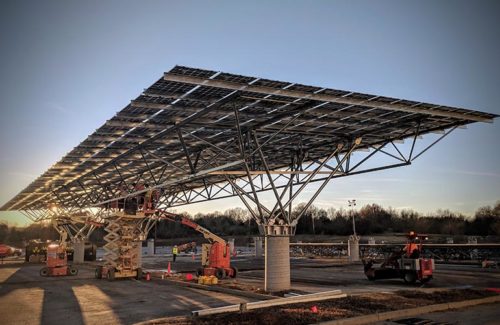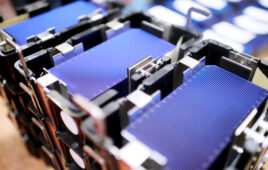By Michael Levitt, sales, Quest Renewables
Developers and EPCs need to move away from pitching solar carports primarily as a means of delivering kilowatt-hours. It is time to look at financing with carports differently; the solar production acts as a means of funding physical infrastructure. It is a different mindset — focusing on the value of structural amenity and its benefits to business owners and their patrons, with the energy savings being the revenue stream which pays off the structure’s mortgage.
 This approach involves breaking away from how solar is traditionally marketed, which focuses heavily on economics, “this is how much you will save by going solar.” While effective for rooftop and ground-mount solar, this methodology falls short when selling carports as it fails to adequately capture the full value of the product. For a rooftop or ground-mount system, oftentimes the goal is to minimize the spatial impact of the system. Customers tend to prefer a solar system that is not obstructive and out of sight, if possible. Solar carports differ fundamentally in that they are an enhancement of the space they occupy alongside the energy they produce. Solar developers and EPCs need to account for the unique benefits solar carports offer and market them accordingly.
This approach involves breaking away from how solar is traditionally marketed, which focuses heavily on economics, “this is how much you will save by going solar.” While effective for rooftop and ground-mount solar, this methodology falls short when selling carports as it fails to adequately capture the full value of the product. For a rooftop or ground-mount system, oftentimes the goal is to minimize the spatial impact of the system. Customers tend to prefer a solar system that is not obstructive and out of sight, if possible. Solar carports differ fundamentally in that they are an enhancement of the space they occupy alongside the energy they produce. Solar developers and EPCs need to account for the unique benefits solar carports offer and market them accordingly.
Shade and Weather Protection
Some of the benefits of a solar carport are easy to identify. In addition to providing shade, these structures also function as a shelter from inconvenient, or even costly, weather events. People are always relieved to have covered parking during rain or snow, but they are even more thankful during a hailstorm. For some businesses, such as auto dealerships, installing a canopy system can lead to a direct economic payback, with many insurance companies offering more attractive premiums and lower deductibles if vehicle inventory is housed under covered parking. These benefits are primary factors driving the sale of standard carport systems and these benefits need to be factored in when communicating with customers.
Enhanced Built Environment
 Moreover, there is inherent value in the carport as an architectural fixture that enhances the business’s built environment, which offers benefits not only for patrons but also employees. When we talked with Armen Zadoorian, senior engineer at AVX, a leading international electronics manufacturing company that completed a nearly 1-MW Quest Renewables carport in 2019, he outlined the numerous benefits the system has on the work environment. “People brag when they get a spot to park underneath the canopies,” he told us, going on to say that employees have started opting to spend their lunch breaks in the now shaded grassy area or sitting in their shaded cars under the canopy. In the case of the system at AVX, the customer not only achieved its corporate goals to produce solar energy, but it in effect expanded the livable space of its work environment.
Moreover, there is inherent value in the carport as an architectural fixture that enhances the business’s built environment, which offers benefits not only for patrons but also employees. When we talked with Armen Zadoorian, senior engineer at AVX, a leading international electronics manufacturing company that completed a nearly 1-MW Quest Renewables carport in 2019, he outlined the numerous benefits the system has on the work environment. “People brag when they get a spot to park underneath the canopies,” he told us, going on to say that employees have started opting to spend their lunch breaks in the now shaded grassy area or sitting in their shaded cars under the canopy. In the case of the system at AVX, the customer not only achieved its corporate goals to produce solar energy, but it in effect expanded the livable space of its work environment.
Aesthetics and Public Image
Aesthetics and public image must also play a central role when making a pitch for solar carports. Sustainability has become an inherent value in today’s society, driving an increasing number of major corporations, such as Amazon, Apple and Delta, to make highly ambitious public pledges to strive toward 100% sustainability and net-zero carbon emission. A well-designed carport can be a powerful, attention-grabbing structure, and businesses can reap the benefits of such an investment in the form of increased positive publicity. This can serve to enhance a business’s public image, communicating that it is forward-thinking and cognizant of its impact on the environment. A solar carport can draw the respect of other like-minded members of the community, functioning as an open invitation to potential patrons to share in that mission.
Conclusion
Whether it be a solar rooftop, ground-mount or carport, each solar system type has its own unique set of advantages and disadvantages which should not be measured against each other using a standard metric. As we recognize that solar carports are distinct from rooftop and ground-mount systems, we must also acknowledge that customers are not uniform in their interests. Doing so will not only allow for a more holistic view of the solar industry’s target customer base but will also encourage the solar industry to expand that market and reach new customer types. If we want to market solar carports — or any solar system for that matter — more successfully, we must look beyond what can be quantified in spreadsheets.





I long for the day that someone, anyone starts covering the seemingly infinite parking lots here in Texas. It is genuinely unpleasant parking my car anywhere but my own garage most of the year. Thanks for the article. Such an untapped resource.
Our apartment complex put solar panels in the parking lot and we got told that our electric bill’s would go down by 15% but I personally haven’t seen it. How long does it take to notice a change? Also do the panels need to connect to our electric meters on our buildings for it to benifet us?
Great questions. Yes, the solar system should be connected to the building Main Service Panels MSP, All solar systems have monitoring capabilities which displays the solar production ( electricity created) and the building consumption (what’s used). Here is the key; if production does not satisfy the consumption? The solar system maybe under sized. What’s % of production was to generate the $15k expected saving? Ask the installing company for the monitoring and expected production report. Hope this helps!!!
Great Article!, My company has designed, fabricated and built several Solar Parking Structures(+2000 kWp) here in Ontario, Canada. In Ontario we benefit from Covered Parking by protection from Snow in Winter and overheating vehicles in the summer months, all while generating clean renewable energy year round. And yes, our solar parking systems are indeed rain proof. The design is the cooperative result from a team of Building Developers, Architects, Structural Engineers, Electrical Engineers and Solar Designers, that addresses, esthetics, function and efficient renewable energy to avoid CO2eq. I would be happy to share our presentation with anyone who is interested.
Hafa Adai,
Do you have any designs engineered for up to 170mph winds? We install solar panels in the island of Guam that is located smack in the middle of what is known as “Typhoon Alley”. Thank you for your time.
Hello Wanjoo,
My name is LT and I work with Quest Renewables, the system design company whose systems are highlighted in this article. Quest Renewables would love to hear more about your needs in Typhoon Alley and discuss partnering in Guam. Would you mind reaching out to us via our contact form? https://questrenewables.com/contact-us/
Be sure to mention your need for typhoon resistant systems. Also please mention Finn, he is currently the leader of our initiatives in hurricane prone regions.
We look forward to hearing from you.
Not mentioned since it is market specific is that for one, auto dealerships can benefit from A. lower insurance costs ( less sun and weather damages ); B. lower maintenance costs ( snow removal, dirt & dust cleaning ) and C. benefit from year round ‘ outdoor ‘ sales and marketing showrooms with lighted and heated showrooms under the array.
Hi Michael, I am a building designer in South Australia and my son owns a mid-sized solar installation company here. I totally agree with your observations and I am appalled at the poor design of some of the major projects that I have seen here and in major sites overseas. The carports are often near useless as carports, rarely waterproof, ugly and with minimal solar efficiency. Some time ago I invented a solar panel system that seems to be much better and simpler than any on the world market at the moment for the carport and general weather-proof building cladding market. Mine is totally waterproof with no need for any fasteners, sealants or cover strips, and the only tools needed are to fix the aluminium mounting rails to the building or carport frame, then the panels are just placed by hand – done! My problem is that there is only one smallish panel manufacturer in Australia and I have no contacts in the field. This system would be absolutely ideal for Tesla, for example. I have an animated presentation that I can forward to a really interested party. Any ideas? Cheers, Bob Tumath
Bob, I sent you an email through your website. My company is in the process of purchasing a commercial solar carport manufacturer and I’d be interested in seeing your presentation.
Id be happy to take a look at the carport design, see if there is value for the US market?. Based in NYC USA EJ Green
Eztal@aol.com
I enjoyed reading this article, as it articulated the benefits beyond the spreadsheet, as noted in the final sentence. The shade, aesthetics, car protection (especially from sun & hail), and public image all add up. Well thought out!
Plus when you realize all the open areas where companies such as GM and Ford park their finished vehicles, the sky is the limit – so to speak.